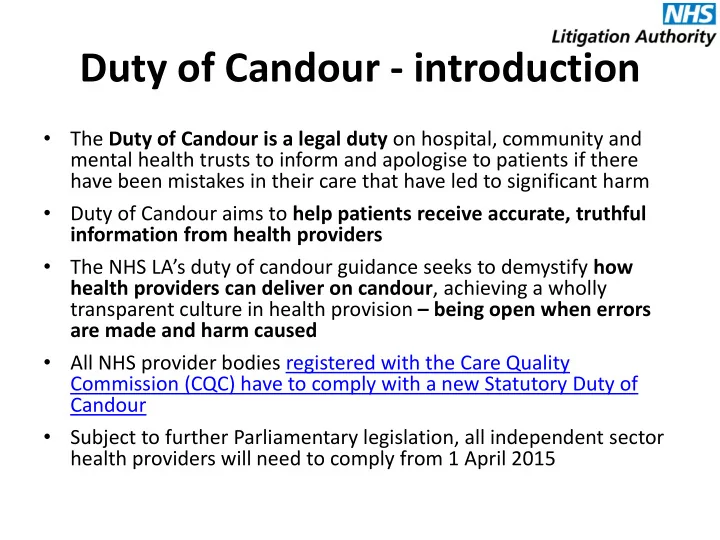

Duty of Candour - introduction • The Duty of Candour is a legal duty on hospital, community and mental health trusts to inform and apologise to patients if there have been mistakes in their care that have led to significant harm • Duty of Candour aims to help patients receive accurate, truthful information from health providers • The NHS LA’s duty of candour guidance seeks to demystify how health providers can deliver on candour , achieving a wholly transparent culture in health provision – being open when errors are made and harm caused • All NHS provider bodies registered with the Care Quality Commission (CQC) have to comply with a new Statutory Duty of Candour • Subject to further Parliamentary legislation, all independent sector health providers will need to comply from 1 April 2015
New NHS LA Duty of Candour Guidance • • Recognising when an incident The death of a patient when due occurs that impacts on a patient in to treatment received or not terms of harm. received (not just their underlying • Notifying the patient something condition). • WHAT TRIGGERS has occurred. Severe harm - in essence WHAT IS • THE STATUTORY Apologising to the patient. permanent serious injury as a CANDOUR? • Supporting the patient further. result of care provided. DUTY OF CANDOUR • • Following up with the patient as Moderate harm - in essence non- your investigations evolve. permanent serious injury or • Documenting the above prolonged psychological harm. discussions and steps. • Open discussions between the patient and the healthcare provider when things go wrong. • Acceptance by healthcare staff • Whilst the patient is an in-patient, that open conversations will take i.e. at the "bedside". place at an early stage. WHAT DOES • • WHEN MIGHT IT When a patient is back at home Reduction in overly defensive CANDOUR LOOK ARISE? following discharge or via approaches to information sharing LIKE? community based care. about incidents in relation to the • Following a patient's death. patient in question. • Engaging the patient with the outcome of investigations; and • An apology in relation to the incident.
What is an apology Clinical staff may worry that Where staff should be more being open with patients may cautious is where the facts are compromise the ability to deal not yet know or where they with a claim if one is are being asked to speculate subsequently made by the beyond what is known. It can patient. In reality candour is all be more damaging to a about sharing accurate relationship with the patient to information with patients and speculate inaccurately than to should be encouraged. The investigate and find the facts facts are the facts and staff and then provide the extra should be encouraged and information. supported to help patients understand what has happened to them.
Saying Sorry
Saying Sorry
1. Do ensure your staff understand your organisation's incident reporting process and accurately report when things go wrong. 2. Do understand what it means to be open with patients. 3. Do ensure your staff understand their role within the organisation's statutory Duty of Candour requirements.
4. Do ensure staff are trained and supported on how to share information with patients when things go wrong both in principle and in practice. For example in relation to the notification discussion they need to have considered: → Where should the conversation take place? → Who should be part of and who should lead that conversation? → What support should be available to the patient during the conversation and afterwards? → Who will be the single point of contact following the discussion with the patient? → Who will capture the discussion in writing and where will that documented account be held? → If the patient is unable to hold the discussion who should be involved on their behalf? (e.g. because the incident was fatal or the patient lacks capacity or the patient wishes to nominate someone to do it for them).
5. Do ensure that when reporting any subsequent claims, copies of the documentation capturing candour in relation to the incident are sent to the NHS LA. 6. Do keep in mind that when something has gone wrong, this can be devastating to the staff involved and therefore do make sure support is available to them. 7. Do encourage feedback from patients about how your organisation is embracing candour and what improvements could be made to your approach.
• Do not forget other avenues by which candour might arise i.e. not only incidents but also complaints and claims. • Do not assume that apologising to patients amounts to an admission in relation to a subsequent civil claim. • Do not miss the opportunity to share learning from such incidents and discussions through your organisation’s internal clinical governance routes.
www.nhsla.com feedback@nhsla.com
Recommend
More recommend